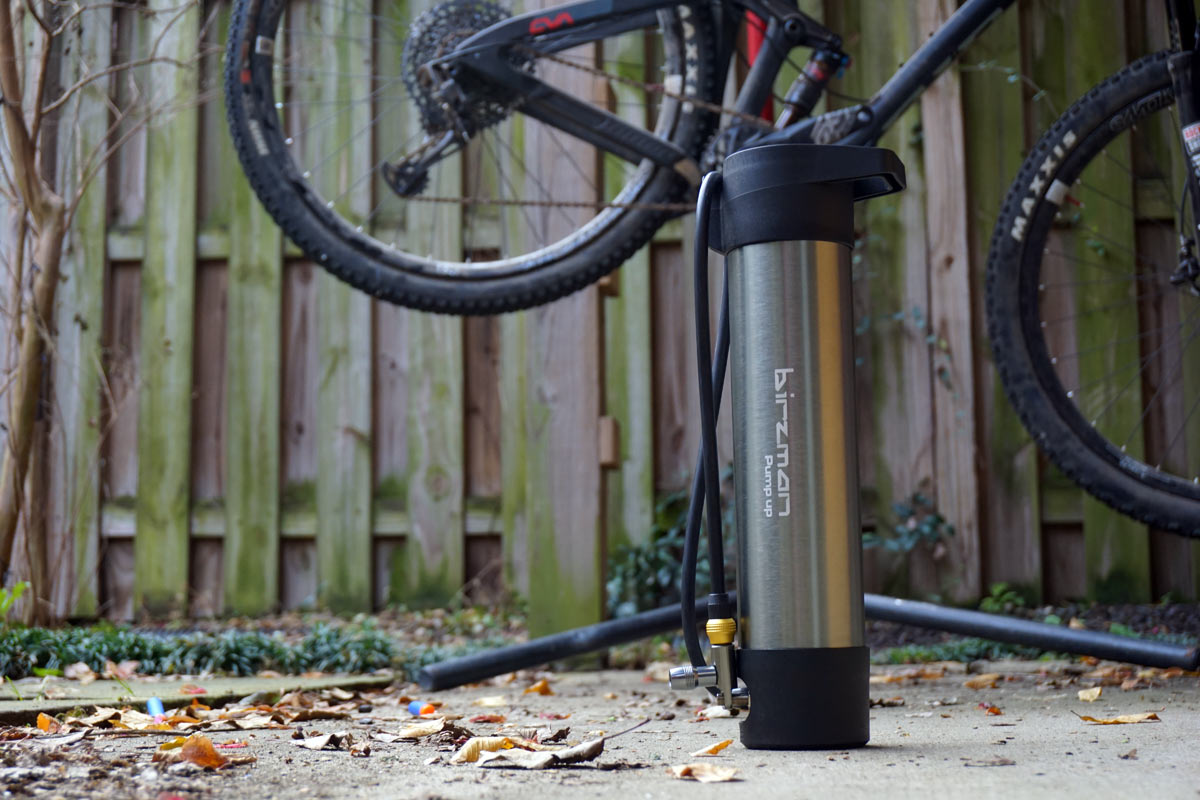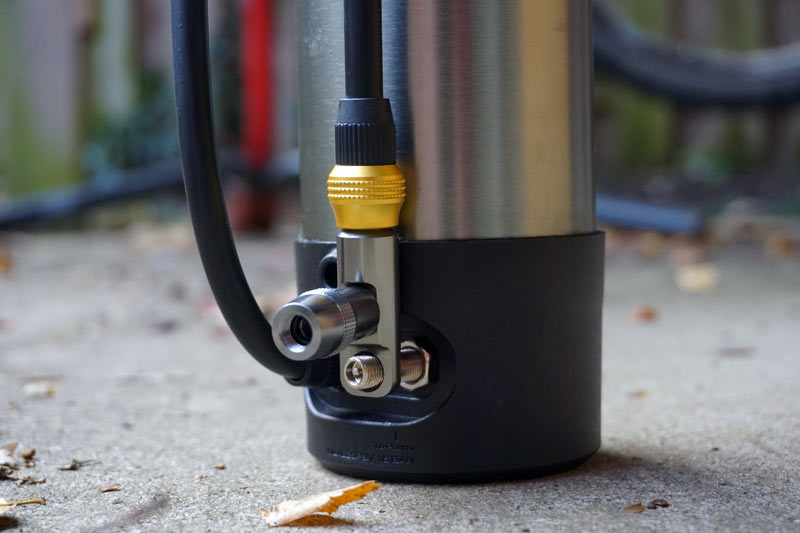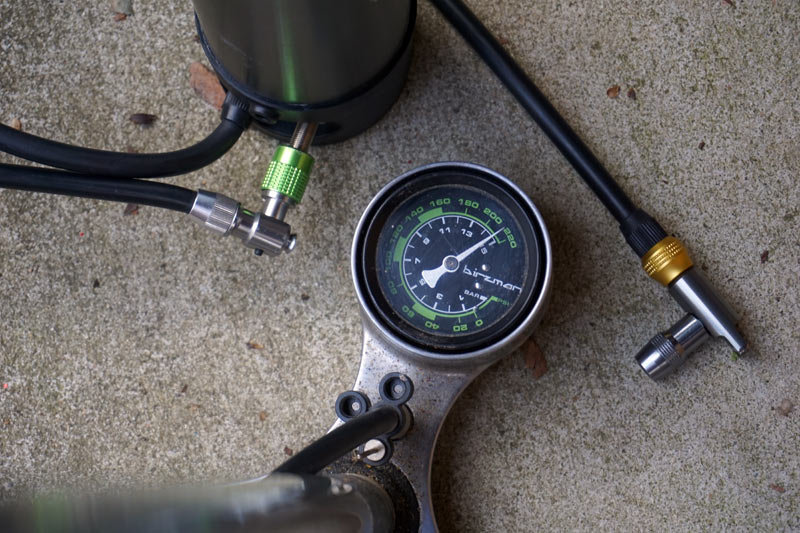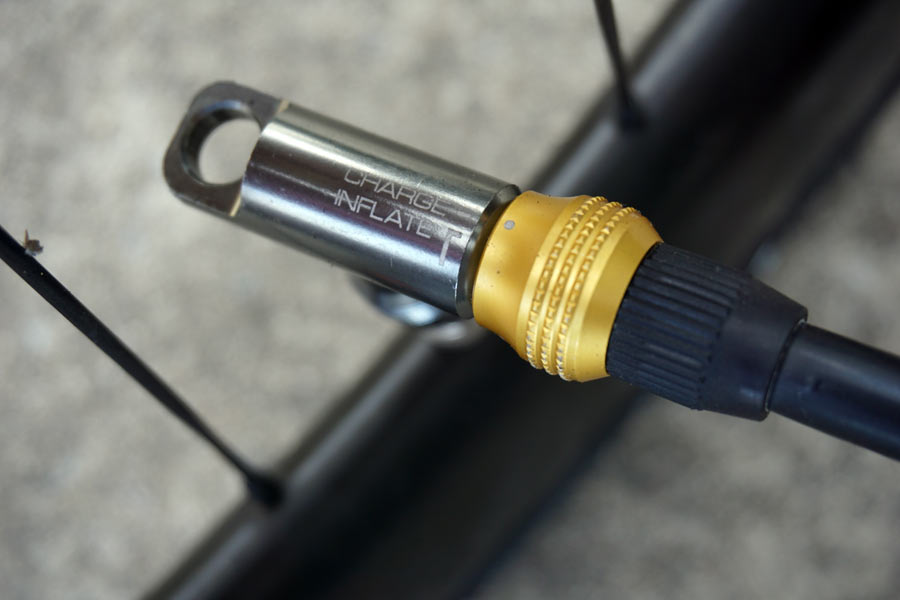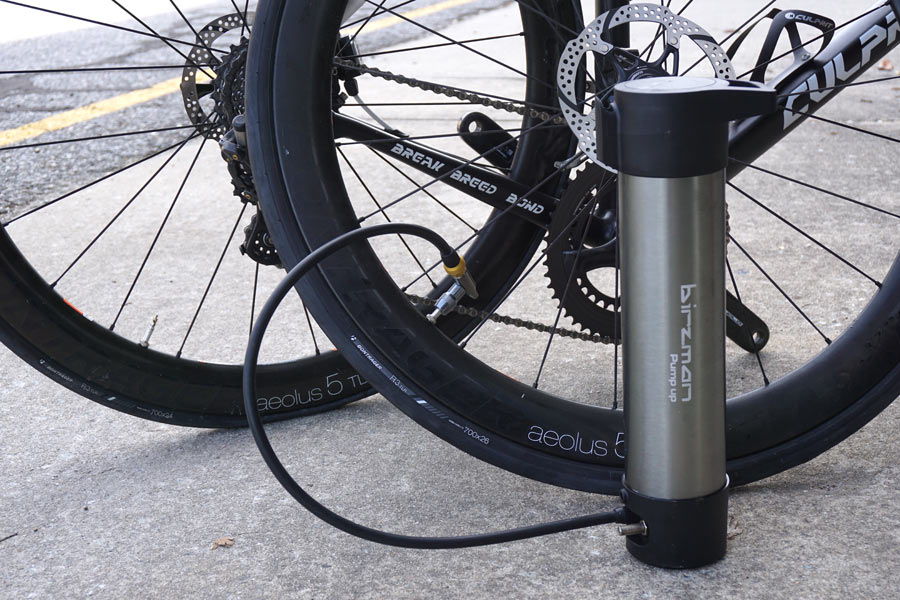Initial setup for tubeless tires can be tricky. Sometimes things come together quickly, other times they need a little (or a lot) of convincing. Either way, you almost always need a big burst of air to get the tire’s bead to seat. The Birzman Pump Up aims to provide just such a gust, offering a 1.2liter canister capable of storing a 220psi charge. We tested it on everything from a 26mm road bike tire up to a 2.35″ 29er mountain bike tire. Here’s how it works…
The Birzman Pump Up is as simple as can be. It’s a nearly featureless canister, with only an input valve and output hose. The inflation hose’s head has a handle hole to hook onto the input to keep it from flopping around in storage.
To use it, thread or clasp any Schrader pump head onto the input and start pumping. I used Birzman’s Maha road pump, which conveniently tops out at the same 220psi that the Pump Up can hold.
If you’ve never owned a track bike or had any other reason to pump something up to 220psi, just know that it is tough. At 200psi, it gets hard. By 210, I had to use my body weight plus effort to compress the pump up to 220psi.
Once topped off, just thread the universal head onto your Presta or Schrader valve and twist the nozzle from Charge to Inflate. This releases the air straight into your tire, and if all else is as it should be, your tire will inflate and seat onto the rim’s bead shelf.
There should be a caveat about any tubeless pump review in that a lot of the success relies on how well that particular tire mates with the rim. If both items adhere to UST or other ETRTO Tubeless Ready standards, then it should be fairly straightforward and having something like the Birzman Pump Up greatly simplifies setup. If not, then no matter how good your air blaster, you may struggle to get the tire to seat. There are tricks worthy of another post, and tried several with one particular tire during testing, but my hunch (based on both difficulty/failure in seating and visual inspection) is the bead was not up to spec because another tire from the same brand seated quickly and easily.
Does the Pump Up really pump it up?
I tested the Pump Up on a new set of road bike tires, a new set of mountain bike tires, and a pre-seated set of mountain bike tires. All were tubeless ready using sealant and inflated with the valve cores in place. Which brings up a point worth noting: The Pump Up doesn’t thread very well onto a core-less Presta valve stem. It still works, but doesn’t seem to grab as tightly as when the valve core is in place, so I held it in place and didn’t hear any air leaking where it shouldn’t. (Side note: For the tubeless newbie, removing the valve core allows more air to move more freely into the tire, which can sometimes make the difference between a tough tire seating or not.)
The road tire test was a brand new set of Bontrager R3 700×26 on the Aeolus 5 carbon rims. I used regular tubeless rim tape, not the included rim strip thing that Bontrager ships with the wheels, and the tire seated instantly and continued inflating to a rideable pressure.
The Instagram video above shows the re-seating of a previously seated mountain bike tire, which was the widest I tested with this device. With the tire completely unseated and all seals broken on both sides, all the way around, it reseated completely in seconds and got to about 20psi. This was a Maxxis 29×2.35 on the massively oversized American Classic Smokin’ Gun rims, so they needed a lot of air. Once inflated, I then deflated the tire but left it seated, and reinflated it with the remaining charge in the Pump Up and got it back to 20psi again with a little left in the tank.
For the new MTB tire test, I seated a set of Vee Tire Co. Mission 29×2.1 on ENVE M50Fifty hookless carbon rims. These were brand new tires out of the box and they seated on the first try. Which was good, because I first tried a different set of Vee 29×2.2 tires and couldn’t get them to seat with the Pump Up, another’s brand’s charge-tank floor pump (160psi max) or my Craftsman compressor (110psi). Some tires just need a lot more convincing than I had time for, but it’s worth noting that the Birzman had the highest psi rating of anything I tried and still couldn’t get it on there.
Overall, the Birzman Pump Up delivered on expectations and I’d recommend it for anyone needing a high pressure solution for seating tubeless tires.
Who Should Buy This?
In my opinion, there are a several use opportunities that make sense, including:
- Roadies who don’t own a high volume floor pump – sorry, but your high pressure pump simply doesn’t move enough air to pop a tubeless tire onto the bead seat. You need to move a lot of air very quickly to make that happen.
- Any cyclist running tubeless who doesn’t have a compressor – or a crappy compressor for that matter. Most home mechanic type compressors are lucky to hit 120psi, which isn’t always enough.
- Any mountain biker without any other high pressure air chamber – because the bigger the tires, the more air you need to blast into there to pop it into place.
- Anyone that races and who’s ever had an issue just when they need to head to the start line – because if you’re racing to the start line and need extra air, there’s not much that’s going to be quicker.
One feature that would be nice is an inline pressure gauge so you know how much pressure is in your tire once inflated. Without that, the Birzman Pump Up is more valuable for initial tubeless set up or emergency quick fixes. Retail is $60, available in bike shops and online.
